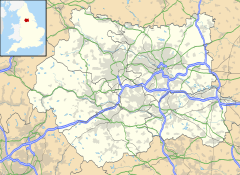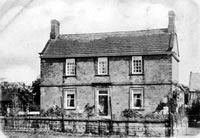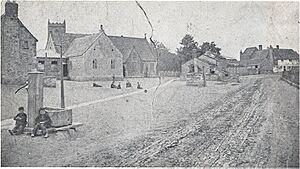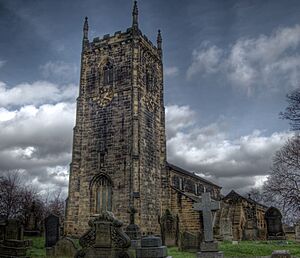Normanton, West Yorkshire facts for kids
Quick facts for kids Normanton |
|
|---|---|
| Town | |
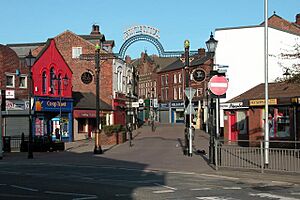 Normanton High Street |
|
| Population | 20,872 |
| OS grid reference | SE385225 |
| • London | 165 mi (266 km) south |
| Civil parish |
|
| Metropolitan borough | |
| Metropolitan county | |
| Region | |
| Country | England |
| Sovereign state | United Kingdom |
| Post town | NORMANTON |
| Postcode district | WF6 |
| Dialling code | 01924 |
| Police | West Yorkshire |
| Fire | West Yorkshire |
| Ambulance | Yorkshire |
| EU Parliament | Yorkshire and the Humber |
| UK Parliament |
|
| Website | https://www.normantontowncouncil.co.uk/ |
Normanton is a town in West Yorkshire, England. It is part of the City of Wakefield. The town is located north-east of Wakefield and south-west of Castleford. Normanton is also home to the Normanton Knights amateur rugby league club.
The area of Normanton and Altofts together had about 20,872 people living there in 2011.
Contents
History of Normanton
The name Normanton comes from "Norman-tune" or "Norman-ton." This means "Norman settlement." The town was once surrounded by a moat. It was chosen for its good views of the area.
The Domesday Book was a big survey made in 1086. It recorded information about 'Norman-tune'. It said the land could be ploughed by five ploughs. There were people living there, a priest, and a church. The land was worth 10 shillings at that time.
When the Normans took over Yorkshire, they built a defensive mound called Haw Hill. This mound likely had a wooden fence around it. This shows that Normanton's name probably came from the Anglo-Normans who settled there.
One of the oldest buildings in Normanton is Hanson House. It was built in the mid-1400s. A newer part was added in the 1700s. The building has been damaged by fire but is now being fixed up.
In 1938, the area of Altofts joined with Normanton. In 2023, the combined area was renamed "Normanton and Altofts."
How Normanton Grew
A grammar school was started in Normanton in 1592 by John Freeston. This building is now called the 'Parish Rooms'.
Normanton stayed small until the mid-1800s. Then, many railway lines came to the town. Work began in 1837 on the North Midland Railway. This line went from Derby to Leeds. Soon, other lines from York and Manchester also reached Normanton. This connected the town to much of the country.
The railway lines crossing the Pennines were 51 miles long. Normanton had the world's longest railway station platform at the time. It was a quarter of a mile long! For about ten years, Normanton station was the most important in England. Over 700 people worked there. About 700,000 passengers used the station each year.
In Victorian times, Queen Victoria even stopped at the Station Hotel. Normanton was also important for moving coal and bricks. Most of these industries closed in the 1950s and 1960s. The last brickworks closed in the mid-1990s.
The railways helped send coal from local mines all over the country. More mines were opened to get more coal. In 1871, Dom Pedro, the Emperor of Brazil, visited Normanton. A coal mine was named Don Pedro Colliery after him. At their busiest, the coal mines employed over 10,000 men. Most of them wanted to live in Normanton. The town grew quickly. By the mid-1970s, most of the coal in the Normanton area was used up.
Changes and Decline
The miners' strike of 1984–85 caused many mines to close. Even though Normanton's own mines had closed, the strike still affected many families. This was because Normanton miners worked in pits in nearby towns.
The area where the St John's Colliery once stood is now a landfill site. The railway station was in bad condition and was taken down in 1986. Today, there is not much left of Normanton's railway or mining past.
Modern Normanton
Normanton has become a growing place for people who work in Leeds. It has affordable homes and good transport links. You can still get to Normanton by train at Normanton railway station. Regular trains go to Leeds, Castleford, Wakefield, and Sheffield Meadowhall Interchange.
The Eurolink Industrial Estate has grown a lot. It is near Junction 31 of the M62 motorway. Many big companies have built their distribution centers here. Normanton is in the middle of the UK. It has good connections to major motorways like the M62 and the M1 motorway.
Landmarks to See
All Saints' Church
All Saints' Church, Normanton is the local Church of England church. It is thought to have been here since at least 1256. It is built in the Perpendicular style, which is a type of old English architecture.
Newland Estate
The Newland estate was a small area near Normanton. It is on the north side of the River Calder. It started in 1213 as a place for the Knights Templar. Later, it was given to the Knights Hospitaller in 1256.
Today, Newland is a nature reserve. The old buildings are covered by plants. The remains of Newland Hall are still there in the woods. It has been empty since 1972. There is also a small fishing area nearby.
Transport in Normanton
Normanton is located just off Junction 31 of the M62 motorway. It has its own train station, Normanton railway station. The town also has bus routes and local taxi services.
Education
Here are some of the schools in the Normanton area:
- Normanton All Saints Primary School
- Normanton Junior Academy
- Normanton Outwood Academy, Freeston
- Newlands Primary School
- Altofts Junior School
- Normanton Common Primary Academy
- St John the Baptist Catholic Primary School
- Martin Frobisher Primary School
- Lee Brigg Infant and Nursery School
Media
Local news and TV shows come from BBC Yorkshire and ITV Yorkshire. You can listen to local radio stations like BBC Radio Leeds and Heart Yorkshire. There is also 5 Towns FM, a community radio station from Castleford. The local newspaper is the Wakefield Express.
Sports
Normanton has two cricket clubs: Normanton St John's CC and Normanton Men in Blue. There are also two football teams: A.S. Normanton F.C. and Normanton Athletic Juniors.
The most popular sport in the area is Rugby League. The main amateur club is Normanton Knights. They play in the National Conference League, which is the fourth level of British Rugby League. The Knights play at Queen Elizabeth Drive Field.
Notable People from Normanton
Many interesting people have come from Normanton, including:
- Paul Anderson – a rugby league player and coach.
- Alice Bacon – a Member of Parliament.
- Lawrence Byford – a senior police officer.
- Ben Cockayne – a rugby league player.
- Billy Conway – a rugby league player.
- Richard Crawshay – an iron merchant.
- Les Cusworth – a rugby union player.
- Reece Dinsdale – an actor.
- John Freeston – who founded a school.
- Levett Hanson – an author and expert on knights.
- Jamie Langley – a rugby league player.
- Joyce Lishman – a leader in social work education.
- Alister MacKenzie – a famous golf course designer.
- Francis Mallet – an English churchman.
- Keith Ripley – a footballer.
- Paul Routledge – a writer and journalist.
- David Topliss – a rugby league player.
- Ben Westwood – a rugby league player.
- Martin Wood – a rugby league player.
- Shaun Winter Taylor-Steels – a drummer for My Dying Bride.
- Duane Holmes – a football player.
Normanton in Film
The old Normanton brickyard was used in the late 1990s for a TV show called A Touch Of Frost. It was the setting for a murder scene. A body was found by the police in one of the old factory kilns. The building was later taken down because it was unsafe. Only the chimney stack remains.
See also
 In Spanish: Normanton para niños
In Spanish: Normanton para niños


